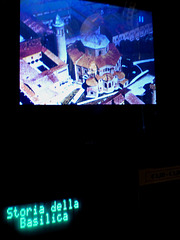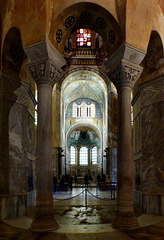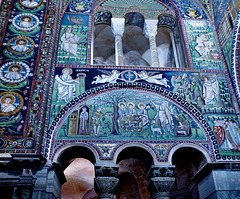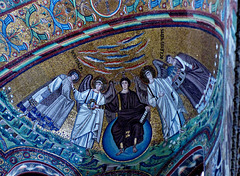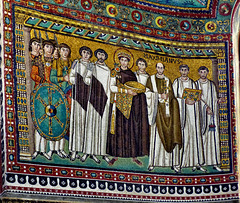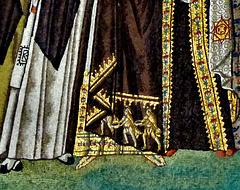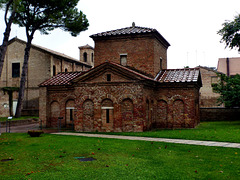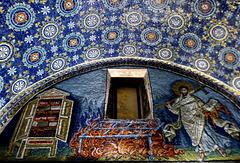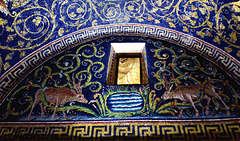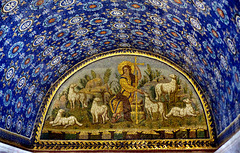
Ravenna
All photos in this album were taken in and around Ravenna.
Ravenna - San Vitale
| |
|
The "Basilica di San Vitale" was erected on an octagonal plan from 526 on, when Ravenna was under the rule of the Ostrogoths, followers of the Arianism. It was completed and got consecrated in 547, when Ravenna was part of the Byzantine Empire.
The church combines Roman with Byzantine elements. It is most famous for its wealth of Byzantine mosaics, the largest and best preserved outside of Constantinople. It is one of the most important examples of early Christian Byzantine art and architecture in Europe.
The impact, that this church had on the Wesern European architecture, can hardly be overestimated. The Palatine Chapel in Aachen, commisioned by Charlemagne, has strong parallels to San Vitale.
Ravenna - San Vitale
| |
|
The "Basilica di San Vitale" was erected on an octagonal plan from 526 on, when Ravenna was under the rule of the Ostrogoths, followers of the Arianism. It was completed and got consecrated in 547, when Ravenna was part of the Byzantine Empire.
The church combines Roman with Byzantine elements. It is most famous for its wealth of Byzantine mosaics, the largest and best preserved outside of Constantinople. It is one of the most important examples of early Christian Byzantine art and architecture in Europe.
The impact, that this church had on the Wesern European architecture, can hardly be overestimated. The Palatine Chapel in Aachen, commisioned by Charlemagne, has strong parallels to San Vitale.
Ravenna - San Vitale
| |
|
The "Basilica di San Vitale" was erected on an octagonal plan from 526 on, when Ravenna was under the rule of the Ostrogoths, followers of the Arianism. It was completed and got consecrated in 547, when Ravenna was part of the Byzantine Empire.
The church combines Roman with Byzantine elements. It is most famous for its wealth of Byzantine mosaics, the largest and best preserved outside of Constantinople. It is one of the most important examples of early Christian Byzantine art and architecture in Europe.
The impact, that this church had on the Wesern European architecture, can hardly be overestimated. The Palatine Chapel in Aachen, commisioned by Charlemagne, has strong parallels to San Vitale.
There are many more stories to tell about "San Vitale". This sophisticated "slot machine" knows them all and it is willing to share them with you for only 2 Euros.
Ravenna - San Vitale
| |
|
|
The "Basilica di San Vitale" was erected on an octagonal plan from 526 on, when Ravenna was under the rule of the Ostrogoths, followers of the Arianism. It was completed and got consecrated in 547, when Ravenna was part of the Byzantine Empire.
The church combines Roman with Byzantine elements. It is most famous for its wealth of Byzantine mosaics, the largest and best preserved outside of Constantinople. It is one of the most important examples of early Christian Byzantine art and architecture in Europe.
The impact, that this church had on the Wesern European architecture, can hardly be overestimated. The Palatine Chapel in Aachen, commisioned by Charlemagne, has strong parallels to San Vitale.
Ravenna - San Vitale
| |
|
|
The "Basilica di San Vitale" was erected on an octagonal plan from 526 on, when Ravenna was under the rule of the Ostrogoths, followers of the Arianism. It was completed and got consecrated in 547, when Ravenna was part of the Byzantine Empire.
The church combines Roman with Byzantine elements. It is most famous for its wealth of Byzantine mosaics, the largest and best preserved outside of Constantinople. It is one of the most important examples of early Christian Byzantine art and architecture in Europe.
The impact, that this church had on the Wesern European architecture, can hardly be overestimated. The Palatine Chapel in Aachen, commisioned by Charlemagne, has strong parallels to San Vitale.
Ravenna - San Vitale
| |
|
|
The "Basilica di San Vitale" was erected on an octagonal plan from 526 on, when Ravenna was under the rule of the Ostrogoths, followers of the Arianism. It was completed and got consecrated in 547, when Ravenna was part of the Byzantine Empire.
The church combines Roman with Byzantine elements. It is most famous for its wealth of Byzantine mosaics, the largest and best preserved outside of Constantinople. It is one of the most important examples of early Christian Byzantine art and architecture in Europe.
The impact, that this church had on the Wesern European architecture, can hardly be overestimated. The Palatine Chapel in Aachen, commisioned by Charlemagne, has strong parallels to San Vitale.
The mosaic, below the triforium, depicts Abel and Melchizedek bringing their offerings to the altar. God´s accepting hand is above the altar. On the adjoining spandrals are Isaiah (upper right) and Moses loosening his sandals before the Burning Bush (upper left).
Ravenna - San Vitale
| |
|
The "Basilica di San Vitale" was erected on an octagonal plan from 526 on, when Ravenna was under the rule of the Ostrogoths, followers of the Arianism. It was completed and got consecrated in 547, when Ravenna was part of the Byzantine Empire.
The church combines Roman with Byzantine elements. It is most famous for its wealth of Byzantine mosaics, the largest and best preserved outside of Constantinople. It is one of the most important examples of early Christian Byzantine art and architecture in Europe.
The impact, that this church had on the Wesern European architecture, can hardly be overestimated. The Palatine Chapel in Aachen, commisioned by Charlemagne, has strong parallels to San Vitale.
Here are Abraham and his wife Sarah.
Genesis 18:1-10
"The Lord appeared to Abraham near the great trees of Mamre while he was sitting at the entrance to his tent in the heat of the day. Abraham looked up and saw three men standing nearby. When he saw them, he hurried from the entrance of his tent to meet them and bowed low to the ground.
He said, "If I have found favor in your eyes, my lord, do not pass your servant by. Let a little water be brought, and then you may all wash your feet and rest under this tree. Let me get you something to eat, so you can be refreshed and then go on your way—now that you have come to your servant."
"Very well," they answered, "do as you say."
So Abraham hurried into the tent to Sarah. "Quick," he said, "get three seahs of the finest flour and knead it and bake some bread."
Then he ran to the herd and selected a choice, tender calf and gave it to a servant, who hurried to prepare it. He then brought some curds and milk and the calf that had been prepared, and set these before them. While they ate, he stood near them under a tree.
"Where is your wife Sarah?" they asked him.
"There, in the tent," he said.
Then one of them said, "I will surely return to you about this time next year, and Sarah your wife will have a son."
Now Sarah was listening at the entrance to the tent, which was behind him."
Ravenna - San Vitale
| |
|
|
The "Basilica di San Vitale" was erected on an octagonal plan from 526 on, when Ravenna was under the rule of the Ostrogoths, followers of the Arianism. It was completed and got consecrated in 547, when Ravenna was part of the Byzantine Empire.
The church combines Roman with Byzantine elements. It is most famous for its wealth of Byzantine mosaics, the largest and best preserved outside of Constantinople. It is one of the most important examples of early Christian Byzantine art and architecture in Europe.
The impact, that this church had on the Wesern European architecture, can hardly be overestimated. The Palatine Chapel in Aachen, commisioned by Charlemagne, has strong parallels to San Vitale.
Ravenna - San Vitale
| |
|
|
The "Basilica di San Vitale" was erected on an octagonal plan from 526 on, when Ravenna was under the rule of the Ostrogoths, followers of the Arianism. It was completed and got consecrated in 547, when Ravenna was part of the Byzantine Empire.
The church combines Roman with Byzantine elements. It is most famous for its wealth of Byzantine mosaics, the largest and best preserved outside of Constantinople. It is one of the most important examples of early Christian Byzantine art and architecture in Europe.
The impact, that this church had on the Wesern European architecture, can hardly be overestimated. The Palatine Chapel in Aachen, commisioned by Charlemagne, has strong parallels to San Vitale.
The mosaic of the apse depicting the garden Eden (watered by four rivers), in which (young and beardless) Christ, seated on a blue sphere and holding seven seals, is flanked by two angels. To the right is Bishop Ecclesius offering a model of the church, to the left Vitalis who is about to be crowned by Christ as a martyr.
Ravenna - San Vitale
| |
|
The "Basilica di San Vitale" was erected on an octagonal plan from 526 on, when Ravenna was under the rule of the Ostrogoths, followers of the Arianism. It was completed and got consecrated in 547, when Ravenna was part of the Byzantine Empire.
The church combines Roman with Byzantine elements. It is most famous for its wealth of Byzantine mosaics, the largest and best preserved outside of Constantinople. It is one of the most important examples of early Christian Byzantine art and architecture in Europe.
The impact, that this church had on the Wesern European architecture, can hardly be overestimated. The Palatine Chapel in Aachen, commisioned by Charlemagne, has strong parallels to San Vitale.
The mosaic under the dome..
Ravenna - San Vitale
| |
|
The "Basilica di San Vitale" was erected on an octagonal plan from 526 on, when Ravenna was under the rule of the Ostrogoths, followers of the Arianism. It was completed and got consecrated in 547, when Ravenna was part of the Byzantine Empire.
The church combines Roman with Byzantine elements. It is most famous for its wealth of Byzantine mosaics, the largest and best preserved outside of Constantinople. It is one of the most important examples of early Christian Byzantine art and architecture in Europe.
The impact, that this church had on the Wesern European architecture, can hardly be overestimated. The Palatine Chapel in Aachen, commisioned by Charlemagne, has strong parallels to San Vitale.
Emperor Justinian clothed in full regalia and standing in the center of a retinue of clergy, officials and soldiers (flanked on the right by Bishop Maximian) bringing the bread of the Eucharist to the altar. He has a nimbus already!
"Justinian the Great" (= Saint Justinian in the Orthodox Church) was born into a peasant´s familiy ~ 482. He made an astonishing career. He was Byzantine (East Roman) emperor from 527 to 565. He tried the empire's greatness and reconquer the lost western half of the historical Roman Empire.
Ravenna - San Vitale
| |
|
|
The "Basilica di San Vitale" was erected on an octagonal plan from 526 on, when Ravenna was under the rule of the Ostrogoths, followers of the Arianism. It was completed and got consecrated in 547, when Ravenna was part of the Byzantine Empire.
The church combines Roman with Byzantine elements. It is most famous for its wealth of Byzantine mosaics, the largest and best preserved outside of Constantinople. It is one of the most important examples of early Christian Byzantine art and architecture in Europe.
The impact, that this church had on the Wesern European architecture, can hardly be overestimated. The Palatine Chapel in Aachen, commisioned by Charlemagne, has strong parallels to San Vitale.
Empress Theodora, bedecked in jewels and purple robes, bringing the cup of the Eucharist to the altar with her attendants.
Empress Theodora was the wife of Emperor Justinian I (see previous upload). Some sources mention her as empress regnant with Justinian I as her co-regent. Along with her husband, she is a saint in the Orthodox Church.
Please note, that her dress is embroidered. The three figures seen there can only be the Magi.
No tourist will ever be alone here. Large groups move around and listen to the guides, who use, as you can see here, laser pointers.
Ravenna - San Vitale
| |
|
The "Basilica di San Vitale" was erected on an octagonal plan from 526 on, when Ravenna was under the rule of the Ostrogoths, followers of the Arianism. It was completed and got consecrated in 547, when Ravenna was part of the Byzantine Empire.
The church combines Roman with Byzantine elements. It is most famous for its wealth of Byzantine mosaics, the largest and best preserved outside of Constantinople. It is one of the most important examples of early Christian Byzantine art and architecture in Europe.
The impact, that this church had on the Wesern European architecture, can hardly be overestimated. The Palatine Chapel in Aachen, commisioned by Charlemagne, has strong parallels to San Vitale.
Empress Theodora, bedecked in jewels and purple robes, bringing the cup of the Eucharist to the altar with her attendants.
Here is a detail of her embroidered robe. The Magi wear the typical phrygian hats.
Ravenna - San Vitale
| |
|
|
The "Basilica di San Vitale" was erected on an octagonal plan from 526 on, when Ravenna was under the rule of the Ostrogoths, followers of the Arianism. It was completed and got consecrated in 547, when Ravenna was part of the Byzantine Empire.
The church combines Roman with Byzantine elements. It is most famous for its wealth of Byzantine mosaics, the largest and best preserved outside of Constantinople. It is one of the most important examples of early Christian Byzantine art and architecture in Europe.
The impact, that this church had on the Wesern European architecture, can hardly be overestimated. The Palatine Chapel in Aachen, commisioned by Charlemagne, has strong parallels to San Vitale.
Not only walls and ceilings are covered with fantastic Byzantine mosaics (see previous uploads), the floor has mosaics as well. Here are three water fowls.
Ravenna - Mausoleum of Galla Placidia
| |
|
|
This building, located next to (younger) San Vitale, was commissioned by Galla Placidia. It was erected 425 - 430 as an oratory dedicated to Saint Laurentius (= Lawrence of Rome). It once was connected to Santa Croce, the church for the imperial palace, built in 417 but now in ruins. Santa Croce was as well commissioned by Galla Placidia.
This is a late Roman building. Though the "The Mausoleum of Galla Placidia" may not have been built as a mausoleum, it now contains three sacrophagi. It is known for it´s mosaics.
Gallia Placida, after whom the building is named, was born ~390 in Constantinople. Her father was Theodosius I, the last emperor to rule over the eastern and the western halves of the Roman Empire. She was granddaughter of Valentinian I and the half-sister of emperors Arcadius and Honorius.
When the Visigoths conquered the Italian peninsula, the "Nobilissima Puella" was captured by Alaric. After his death, she was taken as a hostage to Gaul by Alaric´s brother in law Athaulf in 412. After the Romans had attacked the Visigoths in Gaul, she was not returned to Rome, but married by Athaulf. In 415 Athaulf was stabbed by servants of his successor Sigeric, who then killed Athaulf´s six children (from an earlier marriage) and abused the young widow. Days later Sigeric was assassinated and was replaced by Wallia, a relative of Athaulf. He signed a treaty with Galla Placidia´s half-brother and Roman Emperor Honorius and so she could finally return to Rome.
Honorius then forced her into marriage to Constantius III in 417, who was a sucessful military general and the power behind the throne. In 421 he even briefly became co-emperor of the Western Empire with Honorius.
The couple had two children: Justa Grata Honoria, famous for her plea of love and help to Attila the Hun, and Valentinian III, born 419. After their father´s death and before the political turmoil started, Galla Placidia fled to Constantinople with her kids. When they returned to Italy in 425, Valentinian was installed as Western Emperor at the age of six.
The young Emperor ruled under the regency of his mother Galla Placidia. Her regency ended, when Valentinian reached his eighteenth birthday in 437. Galla Placidia died in Rome in 450 - and was probably not buried in this mausoleum. Her son Valentinian III was assasinated five years later.
Ravenna - Mausoleum of Galla Placidia
| |
|
|
by Galla Placidia. It was erected 425 - 430 as an oratory dedicated to Saint Laurentius (= Lawrence of Rome). It once was connected to Santa Croce, the church for the imperial palace, built in 417 but now in ruins. Santa Croce was as well commissioned by Galla Placidia.
This is a late Roman building. Though the "The Mausoleum of Galla Placidia" may not have been built as a mausoleum, it now contains three sacrophagi. It is known for it´s mosaics.
Here is Saint Laurentius (aka "Lawrence of Rome"), who was martyred in Rome in a gridiron. He was born around 225 in Osca, a place that later changed the name to Huesca (Spain). On the shelf to the left are the four gospels.
-
Gallia Placida, after whom the building is named, was born ~390 in Constantinople. Her father was Theodosius I, the last emperor to rule over the eastern and the western halves of the Roman Empire. She was granddaughter of Valentinian I and the half-sister of emperors Arcadius and Honorius.
When the Visigoths conquered the Italian peninsula, the "Nobilissima Puella" was captured by Alaric. After his death, she was taken as a hostage to Gaul by Alaric´s brother in law Athaulf in 412. After the Romans had attacked the Visigoths in Gaul, she was not returned to Rome, but married by Athaulf. In 415 Athaulf was stabbed by servants of his successor Sigeric, who then killed Athaulf´s six children (from an earlier marriage) and abused the young widow. Days later Sigeric was assassinated and was replaced by Wallia, a relative of Athaulf. He signed a treaty with Galla Placidia´s half-brother and Roman Emperor Honorius and so she could finally return to Rome.
Honorius then forced her into marriage to Constantius III in 417, who was a sucessful military general and the power behind the throne. In 421 he even briefly became co-emperor of the Western Empire with Honorius.
The couple had two children: Justa Grata Honoria, famous for her plea of love and help to Attila the Hun, and Valentinian III, born 419. After their father´s death and before the political turmoil started, Galla Placidia fled to Constantinople with her kids. When they returned to Italy in 425, Valentinian was installed as Western Emperor at the age of six.
The young Emperor ruled under the regency of his mother Galla Placidia. Her regency ended, when Valentinian reached his eighteenth birthday in 437. Galla Placidia died in Rome in 450 - and was probably not buried in this mausoleum. Her son Valentinian III was assasinated five years later.
Ravenna - Mausoleum of Galla Placidia
| |
|
|
This building, located next to (younger) San Vitale, was commissioned by Galla Placidia. It was erected 425 - 430 as an oratory dedicated to Saint Laurentius (= Lawrence of Rome). It once was connected to Santa Croce, the church for the imperial palace, built in 417 but now in ruins. Santa Croce was as well commissioned by Galla Placidia.
This is a late Roman building. Though the "The Mausoleum of Galla Placidia" may not have been built as a mausoleum, it now contains three sacrophagi. It is known for it´s mosaics.
Two deers approaching a spring. This mosaic probably reflects
Psalm 42:1
"As the deer pants for streams of water, so my soul pants for you, O God."
Above the mosaic is a window with an alabaster pane.
-
Gallia Placida, after whom the building is named, was born ~390 in Constantinople. Her father was Theodosius I, the last emperor to rule over the eastern and the western halves of the Roman Empire. She was granddaughter of Valentinian I and the half-sister of emperors Arcadius and Honorius.
When the Visigoths conquered the Italian peninsula, the "Nobilissima Puella" was captured by Alaric. After his death, she was taken as a hostage to Gaul by Alaric´s brother in law Athaulf in 412. After the Romans had attacked the Visigoths in Gaul, she was not returned to Rome, but married by Athaulf. In 415 Athaulf was stabbed by servants of his successor Sigeric, who then killed Athaulf´s six children (from an earlier marriage) and abused the young widow. Days later Sigeric was assassinated and was replaced by Wallia, a relative of Athaulf. He signed a treaty with Galla Placidia´s half-brother and Roman Emperor Honorius and so she could finally return to Rome.
Honorius then forced her into marriage to Constantius III in 417, who was a sucessful military general and the power behind the throne. In 421 he even briefly became co-emperor of the Western Empire with Honorius.
The couple had two children: Justa Grata Honoria, famous for her plea of love and help to Attila the Hun, and Valentinian III, born 419. After their father´s death and before the political turmoil started, Galla Placidia fled to Constantinople with her kids. When they returned to Italy in 425, Valentinian was installed as Western Emperor at the age of six.
The young Emperor ruled under the regency of his mother Galla Placidia. Her regency ended, when Valentinian reached his eighteenth birthday in 437. Galla Placidia died in Rome in 450 - and was probably not buried in this mausoleum. Her son Valentinian III was assasinated five years later.
Ravenna - Mausoleum of Galla Placidia
| |
|
|
This building, located next to (younger) San Vitale, was commissioned by Galla Placidia. It was erected 425 - 430 as an oratory dedicated to Saint Laurentius (= Lawrence of Rome). It once was connected to Santa Croce, the church for the imperial palace, built in 417 but now in ruins. Santa Croce was as well commissioned by Galla Placidia.
This is a late Roman building. Though the "The Mausoleum of Galla Placidia" may not have been built as a mausoleum, it now contains three sacrophagi. It is known for it´s mosaics.
Young and beardless Christ, the "Good Shepherd", holds a golden cross.
-
Gallia Placida, after whom the building is named, was born ~390 in Constantinople. Her father was Theodosius I, the last emperor to rule over the eastern and the western halves of the Roman Empire. She was granddaughter of Valentinian I and the half-sister of emperors Arcadius and Honorius.
When the Visigoths conquered the Italian peninsula, the "Nobilissima Puella" was captured by Alaric. After his death, she was taken as a hostage to Gaul by Alaric´s brother in law Athaulf in 412. After the Romans had attacked the Visigoths in Gaul, she was not returned to Rome, but married by Athaulf. In 415 Athaulf was stabbed by servants of his successor Sigeric, who then killed Athaulf´s six children (from an earlier marriage) and abused the young widow. Days later Sigeric was assassinated and was replaced by Wallia, a relative of Athaulf. He signed a treaty with Galla Placidia´s half-brother and Roman Emperor Honorius and so she could finally return to Rome.
Honorius then forced her into marriage to Constantius III in 417, who was a sucessful military general and the power behind the throne. In 421 he even briefly became co-emperor of the Western Empire with Honorius.
The couple had two children: Justa Grata Honoria, famous for her plea of love and help to Attila the Hun, and Valentinian III, born 419. After their father´s death and before the political turmoil started, Galla Placidia fled to Constantinople with her kids. When they returned to Italy in 425, Valentinian was installed as Western Emperor at the age of six.
The young Emperor ruled under the regency of his mother Galla Placidia. Her regency ended, when Valentinian reached his eighteenth birthday in 437. Galla Placidia died in Rome in 450 - and was probably not buried in this mausoleum. Her son Valentinian III was assasinated five years later.
Jump to top
RSS feed- Latest items - Subscribe to the latest items added to this album
- ipernity © 2007-2024
- Help & Contact
|
Club news
|
About ipernity
|
History |
ipernity Club & Prices |
Guide of good conduct
Donate | Group guidelines | Privacy policy | Terms of use | Statutes | In memoria -
Facebook
Twitter



